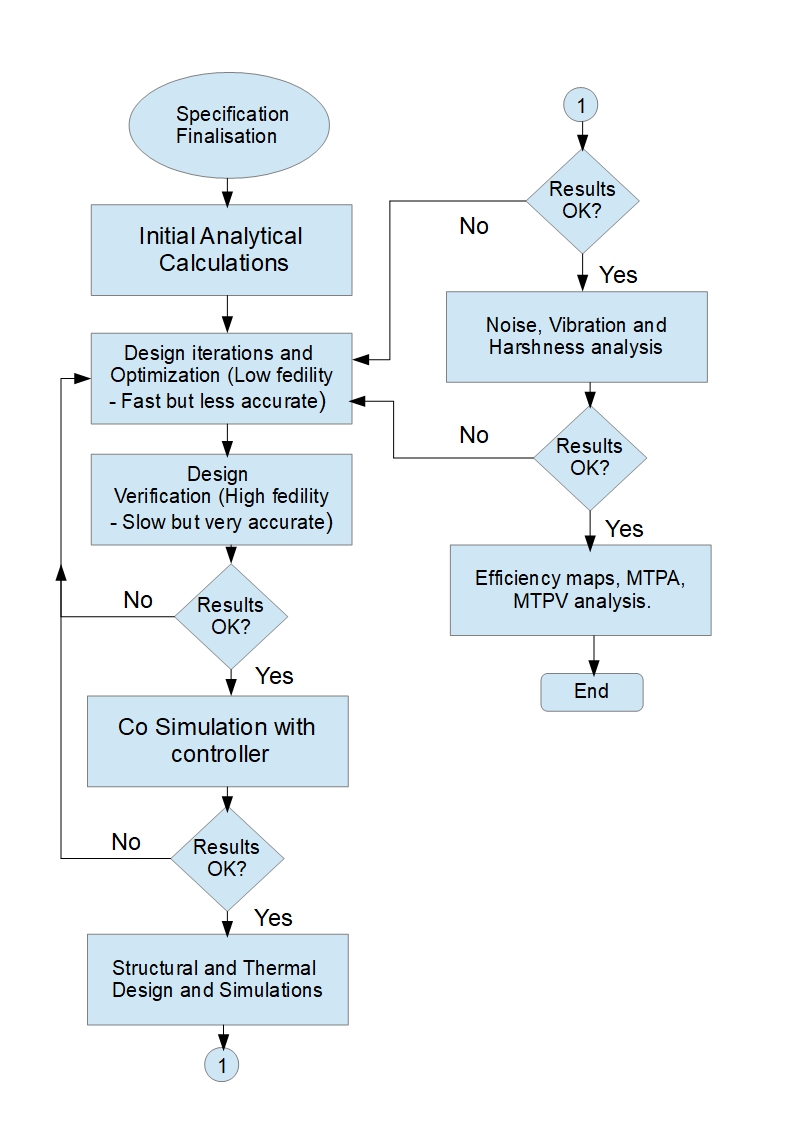Multi- Physics Design Workflow for Electrical Motors
The electrical machine has been rapidly evolved in the last few years. The primary reason behind this evolution and development is adoption of electric motors in automotive industry for Electric Vehicles (EVs) as a primary source of power. The electric motor includes multiple physics like Electromagnetics, Structural, Thermal, and mechanical during its operation. To ensure the optimum design of motor, it must be designed, evaluated, and simulated in a multidisciplinary way. The typical workflow to be used in design of electric motor for traction application is the topic of discussion in this blog.

Specification Requirements and Related Study:
In this stage, the feasibility study of the various motor topologies is carried out considering the specific requirements from the motor viz, Power density, Cost constraint, Cooling system etc. Based on this study the most suitable motor topology is chosen. Induction, PMSM, SRM, SyRM and wound rotor synchronous are a few widely accepted motor topologies for automotive domain to choose from.
Initial Sizing Calculation:
The initial analytical sizing calculations are done for estimating basic details viz. Axial length, bore diameter, specific electric and magnetic loading. These are calculated based on application specific assumptions.
Electromagnetic Design in Low Fidelity Simulation:
The electromagnetic design of the motor includes iterative simulations by variation of geometry and winding parameters until the targeted results in terms of output torque, speed, efficiency are obtained.
Sensitivity Analysis and Optimization:
The sensitivity analysis is performed to study the sensitivity of output parameter to change in input parameter. This analysis gives an idea about which input parameter has most and least impact on the required output parameter.
The optimization algorithm is applied on the various input parameters to find out the optimum value of each parameter that gives most promising results in terms of performance and material consumption. The optimization algorithm makes the optimum trade-off between the two conflicting parameters.
High Fidelity Simulation:
The comprehensive FEA simulation in high fidelity software is performed in this stage on finalized design to re-verify all the crucial performance parameters.
Co- Simulation of Motor and its Controller:
The motor and its controller are usually designed separately but their interaction with each other is also crucial and is required to be verified. Hence Transient- Transient co-simulation of the motor and controller is performed to evaluate overall motor-controller system performance.
Thermal and Structural Design of Electrical Machines:
The structural integrity of the rotor profile is analysed in this stage, if the forces on the rotor exceed safe value, then structural changes are incorporated in rotor.
The thermal response of the motor is then evaluated and accordingly the cooling system is designed and employed for the motor.
Noise, Vibration and Harshness (NVH) Study:
This analysis evaluates the NVH response of the motor. If the NVH level is found beyond limit, then the root cause of the same is identified and then corrected. The NVH response is usually dependent on slot-pole geometry, winding pattern etc.
Advanced Analysis:
The advanced analysis includes mapping of efficiency over complete operating range, MTPA/MTPV analysis, transient thermal response for non-continuous duty ratings etc.
We at ESPL have developed expertise in the domain of electric machines for various application including Automotive, Hermetic, Aerospace. If your team is looking for any kind of support in this area, kindly get in touch with us. Contact details are as below.
Equilibrium Solutions Pvt. Ltd.
Email: info@eqmsol.com
Phone: +91-20-25420085
Contact Point: Mr. Adwait Gokhale
Was this article useful for you? Do provide your valuable feedback.
Note:
The content of this article including other information mentioned on the website www.eqmsol.com is proprietary of Equilibrium Solutions Pvt. Ltd. Unauthorized use/ copy of any content wholly or partly is prohibited. Thanks for the promoting awareness about intellectual properties.